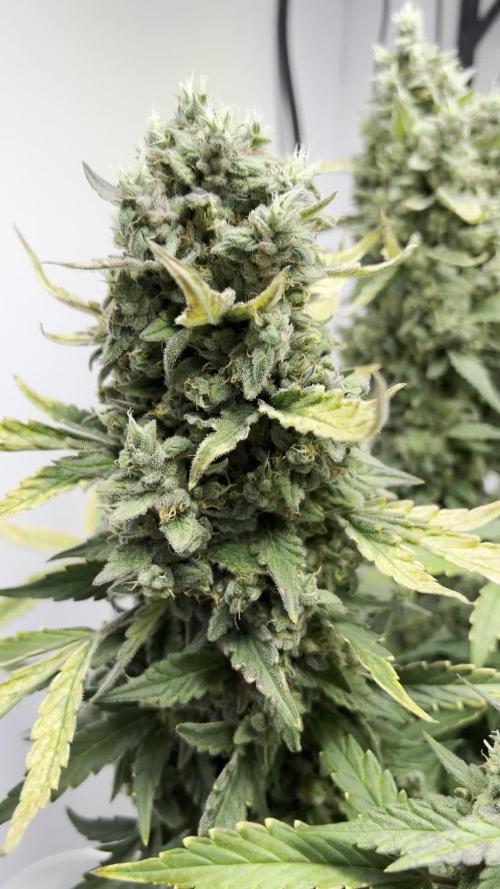The Grow Awards 2026 🏆 































Likes
Comments
Share


@DogDoctorOfficial
Follow
Hey fellow green thumbs! 🌿💚 The day has finally come—our Auto Northern Dragon Fuel from Super Sativa Seed Club has been harvested! After an exciting journey, we’re thrilled to share the details of this incredible plant’s final stage. Let’s dive into the harvest report!
🌟 Harvest Details:
Day 75: Harvest Day
• Harvest Date: Day 75
• Harvest Method: Our beautiful Auto Northern Dragon Fuel was harvested yesterday. After weeks of careful nurturing, the time was right to bring in this amazing plant. 🌿🌼
• Preparation: Before hanging, we meticulously cleaned the plant, removing all leaves without trichomes to ensure a smooth drying process and to enhance the quality of the final product. 🌿✂️
Current Drying Process:
• Method: The entire plant is now hanging upside down to dry. This method helps maintain moisture levels within the buds, allowing for a slower and more even drying process. 🌿🔄
• Environment:
• Temperature: 18-22°C (65-72°F)
• Humidity: 50-60%
Maintaining these conditions is crucial for achieving a perfect dry and preserving the plant’s aromatic and flavorful profile. 🌡️💧
🌟 Plant and Bud Characteristics:
Auto Northern Dragon Fuel:
• Bud Structure: Dense and sticky, with an impressive trichome coverage. The buds are beautifully formed, showcasing the robust genetics of this strain.
• Aroma: Even in the drying phase, the rich and potent aroma is unmistakable. Expect a delightful scent that hints at the powerful experience to come.
• Trichomes: A thick layer of trichomes covers the buds, promising a potent final product with a great flavor profile. 🌿✨
🌟 Care Tips:
• Drying Process: Patience is key. Allowing the plant to dry slowly will enhance the final quality, preserving both flavor and potency. Ensure good airflow around the hanging plant to prevent mold and mildew. 🌬️💧
• Trimming: Once the drying process is complete (typically 10-14 days), it will be time to trim the buds. This is where we’ll shape the final product and get it ready for curing. ✂️🌿
• Curing: After trimming, curing the buds in jars for at least 2-4 weeks will further enhance the flavor and smoothness. This final step is essential for achieving the best possible smoking experience. 🍁
🌟 Genetics Spotlight:
Auto Northern Dragon Fuel:
• Characteristics: Known for its robust structure and dense buds, this strain has shown remarkable resilience and impressive bud development throughout the grow. The final product promises to be potent and flavorful, thanks to the thick trichome coverage and rich aroma.
• Harvest Expectations: High-quality buds with a strong aroma and potent effects. The slow drying process will ensure the best possible preservation of cannabinoids and terpenes.
🌍🌿 Fun Fact:
Did you know? 🌿✨ Drying the entire plant slowly helps retain more terpenes, which are responsible for the plant’s aroma and flavor. This method also helps preserve the potency and quality of the buds, resulting in a smoother and more enjoyable experience.
For all the in-depth action and detailed explanations, head over to my YouTube channel! 🎥✨ I’m sharing all the tips, tricks, and step-by-step guides to help you get the best results from your grow. This week’s harvest has been particularly exciting, and there’s so much more to explore and learn together!
👉 Join me on YouTube Link in my profile 👈
🌟 Conclusion:
Harvesting Auto Northern Dragon Fuel at Day 75 has been a rewarding experience. With the plant now drying, we’re eagerly awaiting the final product. Stay tuned for updates on the drying, trimming, and curing process, and get ready for a high-quality harvest!
Happy growing, and see you next time! 🌿💚✨
#SuperSativaSeedClub #HarvestReport #NorthernDragonFuel #PlantMagic #GardeningJoy #NatureLovers #PlantPower #InspireGrow #YouTubeJourney
Likes
28
Share


@GodZilla_Owner
Follow
The buds are still growing and I have already discovered the first amber-coloured trichomes on Bruce Banner and S.A.D. #4.
I think the harvest will be ready in 2-3 weeks. Until then, I will continue to observe the trichomes with the microscope.
Likes
4
Share


@AestheticGenetix
Follow
This is a fantastic genetic! This is round 2 of growing this genetic.
Breeder: ziplock seeds
Lineage:Banana creme cake jealousy x bonkerz
I took this cutting awhile back, before I flowered the plant this came from.
Expect giant colas and purpling early on.
Check ouy my YouTube for more indepth videos that aren't on here
https://youtube.com/@aestheticgenetix?si=ojXKXPAFAf_vK7-X
Likes
27
Share


@adam_pawloski87
Follow
Let’s Go day 29!! This week went real nice ! Girls are staying very healthy and building up nicely and even started showing signs of female sex which is super great ! We started doing a little bit of leaf tuck training method on em , nothing to big as like I said I want these girls just to do there thang an grow more on naturally side! My Air temp and Humidity have been on point all week, staying from 70-75 degrees throughout the day and humidity staying around 58-61% humidity , my girls are loving that summer an 75 feeling !! Can’t wait to see what we do this week ! Hopefully you all enjoy, and are ready for another great productive week ! Peace love an positive vibes to y’all Cheers 😶🌫️💨💨💨💨🤙🏻Happy Grows✌️🏻Week 4 let’s get it !
Likes
11
Share


@Farmerskr
Follow
Me encanto esta semana, gran avance en las 2 Gorilla Rainbow y gran avance tmb en las 2 White Gorilla.
BSF Seeds sin duda está haciendo un gran trabajo…
Se les hizo más podas apicales y defoliación, y reaccionaron perfecto.
Así damos por finiquitada la 4ta semana de vegetación y espero darle unas 2 semanas mas.
Saludos cultivetas
IG: @farmer.skr 🤙
Processing
Likes
100
Share


@TheFairyBudMother
Follow
Getting my supports into place and then will flip this coming week. Mites seem under control, still using soap spray and systemic spinosad in watering. The two middle most plants are Ice Bomb. I have not been feeling well so I have not pulled them all out for photos this week.
Likes
12
Share


@cookingwithninja
Follow
day 49 just pure water phed down.
it is day 51, morning before lights on, I might chop today. I use a zero water filter pitcher got off walmart. My humidifier is only a sonic wave. If you use regular tap water it will get gunky in a sonic humidifier. If you have a heat humidifier that boils the water the mist should be clean. These are the 2 types of water humidifiers. Researching best water filters this "zero water" also comes with a free ppm meter! yay! Other water pitcher brands; the water still has ppm. So water misted will still have ppm contamination. You can easily used distilled water only, and reverse osmosis. I just fill a 4gal office water jug with the pitcher and fill my humidifier when needed. I do not use a humidifier in my entire grow up to this point when I chop, I need the perfect rh or this whole effort can fail. growing up to this point only requires 20% effort, chopping now for the 2 weeks dry is this 80% of crucial determination, succeed. A lot of tasks are required today for a clean chop. I feel confident, observed my cross seeds with pink paradise and one with a slightly open caylex looks dark enough for successful germination. I figured 8-16 seeds may be created, 3-4 buds were potentially pollinated. Many growers don't understand when creating genetics with female/female there is a slight chance of herm. You lose 50% of your genetic function. Just water last 2 days, no humic no folvic, 1st time entire grow ha!
There is a lot of cleaning to do, remove the trees, clean the entire tent and environment with bleach water, hacksaw.
I am very proud of my grow. I have sampled 3 of the strains, dr. thunder legit made my lips numb but it could have just been the terps removing my skin cells from the sticky filter, no lie. This is my best grow to date. I did this for you, and to document hype or not under the best conditions I could give my plants, full max potential, although I wish I had more lights, I am not looking for industrial lol, this is how I grow. Learn a lot on youtube and podcasts there is many good content and I may dab into it. You can have a room full of growers and you have 1 seed in your hand, they will all tell you that their way is correct ;) and the best way. Oreo is stinky AF, Bridal is just amazing glad its massive, just not into sativa but the test seemed slight sativa with majority indica, pink untested, dr, thunder just a lip numming plant aha, its very nice, all 4 amazing appeal like advertised, and excited for next run. Either crosses from this or other copycat genetics.
I will give you beautiful glamout shots today, the sizes of the plants, My guesstimate bridal 1lb, thunder 1lb, pink, 0.4lb, bridal 0.5, I am ambitious off 640w lm301h, and 4x 20w blurples daisy chained.
day 51 4 chopped see you in a few weeks :D
Likes
8
Share


@Pierrougarou21
Follow
2 jours de la 7 eme semaines nous commencons a apprecier la dtructure des fleurs qui sera de classe A par son aspect et sa densité
Likes
12
Share


@CheeRz
Follow
The year is almost over and I think we can look back on a very successful 2024. Happy new year 🎇🎆 and lets have a great 2025 🚀💚with big and juciy crops
Likes
54
Share


@ASCBOOGS
Follow
Day 43 veg been doing LST and super cropping but dunno if i should top all the bud sites please could someone give me some advice on that as I have never grown clones before
Day 45 looking a bit better after super cropping and fimming all bud sites
Likes
33
Share


@Titoff
Follow
Depuis la fin de la semaine 10, j’avais commencé mon rinçage après avoir observé les trichomes à l’aide de différents appareils, microscope de poche vendu dans les Growshops, microscope à fixer sur son smartphone ou encore les lentilles macro de type Apexel lens 2 en 1.... Les lentilles macro m’ont permis de voir de manières assez aisées que ceux-ci étaient pour la plus pars laiteux, j’avais donc pensé que c’était le moment pour moi, d’entreprendre ma période de rinçage. J’avais lu sur différents sites qu’il fallait effectuer 2 semaines de rinçages afin d’éliminé tous trace de nutriments et d’avoir un weed savoureuse. Je pensais donc que le timing était bon et que mes 2 semaines supplémentaires me donneraient les 15 à 20% de trichomes ambrés mais j’arrive à la fin de la première semaine de rinçage et très peu d’ambré. J’ai donc ce weekend redonné un peu d’engrais, car les feuilles sont en pleines sénescences et la maturation des trichomes demande encore un peu de temps. Un peu perdu, pour être honnête, le contrôle de ce jour montre un stress plutôt bénéfique pour les filles qui vont être à nouveaux rincées. Afin de m’aider au mieux, j’ai commandé l’appareil Higrade analyseur de cannabis que je recevrais lundi, je vous donnerais donc plus de détails par la suite mais cet appareil est sensé nous donné de précieuses données quand coupé, taux de THC, carence, maladie bref un gadget qui promet de belle prouesse à voir donc. Cependant après plusieurs recherches, j’ai appris que l’on commençait son rinçage seulement quand les trichomes devenaient ambrés et après 10 jours de rinçages et après on coupe....
Likes
28
Share


@Elysian_gardens710
Follow
It's the 4th week of Flower!! I've gotta say, counting weeks is tough and I always get it mixed up. 0-7 days is 1 week. So this is week 4, days 21-28. I do some reason feel like the 28th day should be the start of week 4 but it doesn't work that way...idk sorry bout the rant!
This week I wont do a day by day as nothing has happened per those days. Except for Thursday. Day 27 of flower.
Every Thursday we water in the Teas and recharge. I also, lollipopped her this week and removed some of the larger fan leaves. CMOG is the heaviest plant as it is and some great spacing between buds ensure hood light penetration.
She is getting super stinky and frosty too!! Cannot wait for 1 more week for her to really pop!!
Likes
17
Share


@valiotoro
Follow
Hello everyone week 4 of flower has passed for this Cinderella Jack auto 👸🏼
For the feeding schedule i stopped feeding Power Roots and Pure Zym and started feeding Green Sensation 0,5/l
Mars hydro SP-6500 power 75%
have a great day and wish you all happy growing 😎👨🌾🏻
Likes
4
Share


@AustinRon
Follow
El Diablo Week 11 - Flower 9
[Twenty20Mendocino]
(X-Factor X Whiskey Zulu)
Overview -
- We’ve lowered Lighting to 50%, in an attempt to to lower overall temperature through end of grow.
- Full Watering every 4 - 7 days (If not harvested)
Objective
- Trained Plant - @3Nodes - Bend apical meristem to Node 1 Height, 7 STEMS . . .
Week 11 : [ Fri
Apr 11, 2025, ED 1Q25 78:F:11:1]
[ Thu Apr 17, 2025, ED 1Q25 84:F:11:7]
24/0 @ Germination through 24 Hour Open Cotyledons (then 18/6)
Germination: 25 Jan 2025
#3A Earliest Harvest Date: Thu Apr 10 2025
#3B Latest Harvest Date:
Mon April 21, 2025
__
Fri Apr 11, 2025
ED 1Q25 78:F:11:1
Observation:
We’re wrapping up - but see clear signs of More NITROGEN than I’d like …
We’re STILL pushing fresh Pistils.
Would like to have a few more days of High Potassium (RLA - Resin Bloom) in hopes of hastening senescence.
Pre-Lights Out
1L - Resin Bloom @8ml/gal, 2 to go
Full Watering
2 Liters
- [x] Photosynthesis Plus: [ 4.5, ml] # [ 6, ml, gal]
- [x] Resin Bloom: [ 7, ml] # [ 8, ml, gal]
Then, for each Liter Delivered
- Quillaja 60 Powder: [scant]
__
Sat Apr 12, 2025
# First Harvest Oppty
ED 1Q25 79:F:11:2
No Water Today
__
Sun Apr 13, 2025
ED 1Q25 80:F:11:3
No Water Today
__
Mon Apr 14, 2025
ED 1Q25 81:F:11:4
No Water Today
__
Tue Apr 15, 2025
ED 1Q25 82:F:11:5
No Water Today
__
Wed Apr 16, 2025
ED 1Q25 83:F:11:6

No Water Today
__
Thu Apr 17, 2025
ED 1Q25 84:F:11:7
Watering Today (If No Harvest Yet) : 2 Liters
- [x] Photosynthesis Plus: [ 4.5, ml] # [ 6, ml, gal]
- [x] Resin Bloom: [ 7, ml] # [ 8, ml, gal]
- [x] Quillaja 60 Powder: [scant]
Likes
11
Share


@RomeoAlphaWhiskey
Follow
day78: watered 6.4ph
day80:watered 6.5ph
day83:watered 6.1ph
day85: watered 6.2ph
give ζamensia a try, genetics are ON point.
Likes
11
Share


@DeepRootsGrowTrees
Follow
FORBIDDEN 🚫 RUNTZ by FASTBUDS
Week #4 Overall June 22nd-29th
Week #3 Veg
She's looking good this week she's a busy plant with side growth no issues this week. Stay Growing!!
Fastbuds FORBIDDEN 🚫 RUNTZ






















